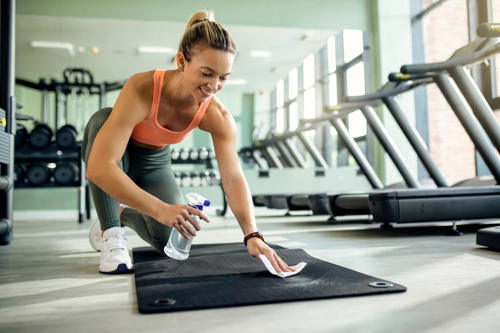How to clean a yoga mat effectively
26 August 2025

Whether you prefer the calming flow of Hatha or Restorative yoga or the intensity of Bikram or Power yoga, keeping your yoga mat clean is essential.
In this guide, we’ll look at why cleaning your yoga mat is important and how to do so effectively for a range of different mats.
Why do you need to clean your yoga mat?
You might wonder why it’s so important to clean your mat. Well, yoga mats can easily become a breeding ground for germs.
As you move and sweat, moisture can seep into the mat, creating the perfect environment for bacteria to grow. Over time, this can lead to unpleasant smells, dirt buildup, and even skin irritation. Wiping down your mat after every use helps prevent these issues.
Regularly cleaning your mat not only helps keep it hygienic but also extends its lifespan. A deeper clean once a month with a gentle disinfectant will keep your mat feeling fresh and looking great, too.
If you practice in a studio and use shared mats, cleaning is even more important. Studio mats can carry germs from one person to another, so always wipe them down thoroughly before and after use to reduce the risk of cross-contamination.
How do you clean a yoga mat?

Choosing the most effective way to clean your yoga mat will depend on the type of mat you have. Yoga mats can be made from a range of materials, with some thick and others on the thinner side.
Let’s look at the common materials used and the best ways of keeping them sparkling clean.
- PVC yoga mat: This is a popular, affordable option, but it’s not the most eco-friendly. Known for their durability and excellent cushioning, these mats provide a stable, supportive surface. They’re ideal for beginners or those who prefer extra padding, and the textured surface of PVC mats provides decent grip. However, they may become slippery when wet, making them better suited for low to moderate-intensity styles of yoga like Hatha or Yin. To clean a PVC yoga mat, you can make a homemade solution by mixing warm water with a few drops of gentle soap or vinegar. Use a soft sponge to wipe down the mat and rinse with lukewarm water. Dry using a cloth or leave to air dry naturally. It’s important to make sure the mat is completely dry before rolling it up.
- TPE (thermoplastic elastomer) yoga mat: These mats are environmentally friendly and sustainable; however, they aren’t quite as durable as other materials. TPE mats offer excellent cushioning and resilience, making them comfortable for both gentle and dynamic yoga styles. They provide good grip and traction, even during sweaty sessions, and are often odour-free, which is great for sensitive users. TPE material is also closed-cell, meaning it resists moisture and bacteria buildup, making the mat easy to clean and maintain. To clean this type of mat, avoid using any harsh chemicals and stick with a homemade solution of warm water and soap or vinegar.
- Natural rubber yoga mat: Durable with great grip and cushioning, these yoga mats are a popular choice amongst yogis. To keep your natural rubber yoga mat in good condition for longer, though, it's important to clean it regularly. Use a gentle mixture of mild soap and water to wipe it down, steering clear of harsh chemicals that could damage the rubber. After cleaning, let the mat air dry completely to avoid moisture buildup and reduce the risk of mould.
- Cork yoga mat: Cork yoga mats are a favourite among yogis for their sustainability and long-lasting quality. Harvested from the bark of cork oak trees, they are both renewable and eco-friendly. Cork is naturally non-slip and offers excellent grip, even during sweaty sessions. Its antimicrobial properties help resist bacteria and odours. Lightweight and easy to transport, cork mats lay flat without sliding or bunching, providing a stable, comfortable surface for your practice. To clean your cork yoga mat, gently wipe it with a damp cloth using either a mild soap and water mixture or a 50/50 blend of water and white vinegar. After wiping, rinse with clean water and allow the mat to air dry fully before rolling it up with the cork side facing out. Avoid using harsh chemicals, scrubbing too hard, or soaking the mat, as this can damage the cork.
- Cotton yoga mat: Cotton yoga mats are a traditional and eco-friendly option, often used in styles like Ashtanga and hot yoga. Made from natural cotton fibres, these mats are breathable and absorbent. They provide a comfortable surface for practice and are especially effective at absorbing sweat, offering better grip the more you perspire. Cotton mats can be used alone or layered over a standard yoga mat for added cushioning and traction. They are lightweight, machine-washable, and biodegradable, making them a sustainable choice.
What's the best way to clean a yoga mat at home?
Homemade solutions are a cost-effective way to clean your yoga mat. A simple concoction of warm water and a few drops of washing-up liquid is a great, hassle-free cleaning method. You can also add a few drops of your favourite essential oil, too. Don’t use too much soap, though, as this can make your mat slippery.
Vinegar is also a great cleaning agent for yoga mats. Mix one part vinegar with three parts water in a spray bottle. You can also add in a few drops of tea tree oil, as it has antimicrobial properties that can help to mask the vinegar smell.
Shop-bought yoga mat cleaning solutions are available to buy and are also a convenient option. Many are plant-based and don’t contain any nasty chemicals, protecting your health and the longevity of your yoga mat.
If your mat gets particularly dirty, deep cleaning it once a month is a fantastic idea. A simple way of doing this is in the bath. Fill the bath up with warm water and add a bit of washing-up liquid to it. Allow the mat to soak for 10 minutes, then gently rub it with a soft cloth, scraping away any dirt. Finally, rinse the mat with water to remove any residue and allow it to air dry naturally.
Specialist yoga insurance through Insure4Sport
Keeping your yoga mat clean is always important, whether you’re a yoga instructor or enjoying a class yourself.
If you take part in yoga regularly, you may want to consider yoga insurance to protect you should something go wrong.
Specialist yoga insurance through Insure4Sport can safeguard you and your yoga equipment against things like theft, loss and damage. Get a quote online today to see how much your cover could cost.
Please note the information provided on this page should not be taken as advice and has been written as a matter of opinion. For more on insurance cover and policy wording, see our homepage.
Got a question? Call our UK call centre 08000 92 92 68
©Copyright Ripe Thinking Limited 2025.
Insure4Sport® is a registered trademark and a trading name of Ripe Insurance Services Limited which is Authorised and Regulated by the Financial Conduct Authority No.313411. Registered office: The Royals, Altrincham Road, Manchester M22 4BJ. Registered in England No. 04507332.
